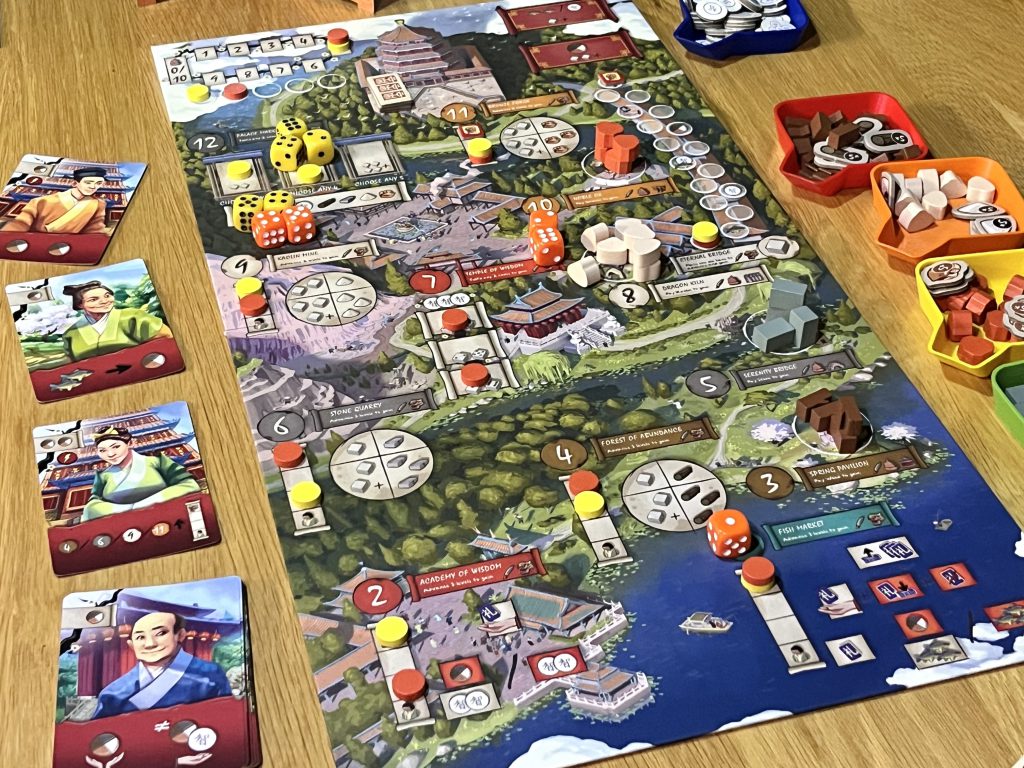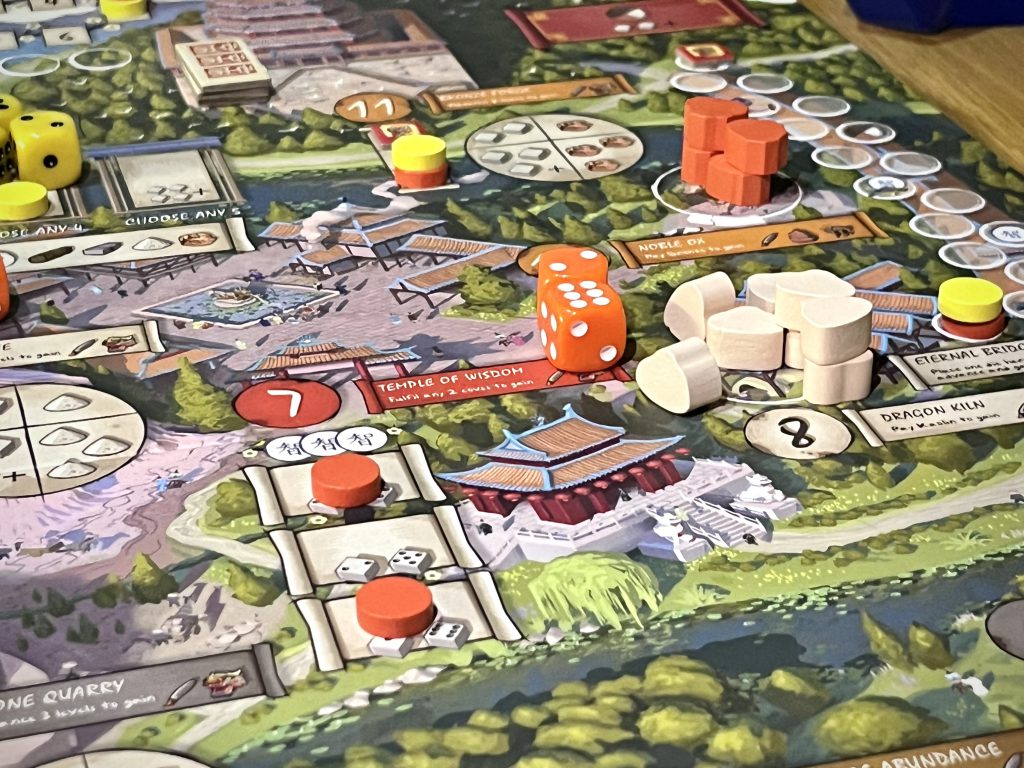Eternal Palace takes painting by numbers to a whole new level
The Emperor can be tricky to please. Eternal Palace from Alley Cat Games is designed by Steve Aramini with art by Quentin Regnes. This dice placement game sees players take on the role of Chinese nobles seeking to earn the most imperial favour.
Each round begins with players rolling their dice and comparing totals to establish turn order. Next follows the head scratchy analysis paralysis bit of the elegant efficiency puzzle at the heart of Eternal Palace. Having cast their dice in public, players now group their dice into groups of one or more under cover of the dice screens with their handy printed rules reminders on the reverse. The purpose of this secret planning phase? That has to do with the various locations printed on the beautiful and thematically illustrated board. Perhaps you wish to pay your respects at the temple in a bid to grow your wisdom? You’re going to need dice totalling exactly seven. Or maybe you’d like to take in the fresh sea air at the fish market down by the docks, such an action demands a lonely one on the die.
The purpose of all these number based shenanigans is, as I mentioned before, to end the game as the noble with the most favour (points) in the Emperor’s court by raising monuments in his honour and immortalising the glory of his palace in watercolour (it might be oils, I’m not an artist). This is accomplished by strategically placing your dice in turn with your rivals to visit the fifteen unique locations on the board. Locations one to twelve demand the corresponding total on the chance cubes. The remaining three locations are more forgiving in terms of entry requirements ensuring that an unfortunate roll of the dice does not completely sabotage your artful designs and see your march to glory grind to a halt.
Roll dice, activate locations… Got it! Most locations allow you to gather resources or advisor cards, others allow you to contribute to the building of those marvellous monuments we mentioned. Some advisor cards grant you powerful one-off benefits while others provide useful abilities that can be deployed every round. All of this feeds into your central aim of earning favour with a dazzling painting.
When you visit a location you will move up a little track on the board. After fulfilling the requirements a few times you will be rewarded with the corresponding numbered painting piece for you to position proudly on your developing miniature canvas. As an extra incentive to be the first artist to tally up the required number of visits to a location you will receive a unique special feature for your painting worth an additional point at game end. The game ends when one player reaches eight painting layers each of which are worth a point as are painting features, monument tokens and the special tokens which can be earned by fulfilling certain conditions. Does all of this create a fun mix?

Eternal Palace revolves around dice worker placement and uses a fairly forgiving and accessible version of this mechanic. Multiple players can visit the same location by simply paying a penalty in fish if you are not the first to do so. Eternal Palace also allows for some mitigation of the dice roll by using wisdom tokens to modify results, much like workers in Castles of Burgundy. The availability of fish and wisdom in the game means that you will rarely be completely blocked from your preferred locations, even at higher player counts.
Once everyone knows what they are doing a few rounds in, the game feels like a tight and enjoyable race as you seek to beat your rivals to the top of the various tracks. Especially with four or five players racing up the track it can lead to some interesting choices between using single dice for more placements or grouping them to make sure you get the best spots for your painting. That said the game also feels like a tight dual with two players.
My favourite mechanic in Eternal Palace concerns the monuments, each of which is tied to one of the four resources: wood, stone, bronze and kaolin. Players contribute to the monuments by placing resources equal to what’s already there. If there are already two bronze tokens for example you would need to place two more, leaving the next visitor trying to match four and so on. The most recent contributor to each monument becomes the custodian of its one matching token or miniature should you splash out on the deluxe version. I enjoyed the challenge of deciding the right moment to swoop in and claim a monument for myself and leaving it too expensive to be worth the effort for others to claim back. With scores often in the ten to fifteen range those few extra points can be crucial.
The board looks fantastic and really sells the theme, we know where we are in the world at a glance. The board artwork, despite being beautifully detailed, doesn’t distract from the information presented. However, it is not the biggest and does feature a lot of placement locations none of which have a designated area for the dice as many worker placement games do so it can feel a bit cluttered at four or five players as everyone’s dice hit the board. The race along the tracks can be a little fiddly as you seek to move your marker along the small spaces without bumping others, no small feat for my sausage fingers. Some of the iconography and text are very small and can be tricky to identify at first, but most of the locations are simple enough that once you are familiar with them you won’t be referring to the iconography anyway.

The actual painting layers which sit on your little easel look fantastic and feel very satisfying as you collect them and build up your winning vista. No doubt like me you will find yourself wanting to take a snap of your creation when it’s all over. Sorting the numbered layers at the game end and start does take a good few minutes, though the Eternal Palace includes a nice little tray for storing and displaying them during play. Likewise, the little wooden resource tokens are very nicely finished and good to handle, however, quite a few of the components are also cardboard tokens so be prepared to get bagging if you like to keep everything organised and not sloshing around at the bottom of the box.
The advisor cards which are usually obtained at the fish market (not sure) or academy of wisdom (ok that makes sense) feel quite samey in terms of their art, in fact, one or two are identical which feels like a missed opportunity in a deck of forty cards. I often found myself flicking through the rulebook to check the effect of a card. It feels like an oversight that the cards themselves are not numbered to speed this process and with so many of them looking quite similar, it became a game of guess who on occasion.
Depending on which version you go for there are several expansion modules included which can help mix things up when you are familiar with the base game and have a few victories under your belt. Go deluxe and get more!
I enjoyed my time with Eternal Palace though the initial teach can be a bit overwhelming with all the locations so it might just be best to dive in as the underlying mechanics are pretty accessible. The last few rounds of racing to complete your canvas are genuinely tense and exciting. The art is fantastic overall and the game has great table presence. It just feels like some of the design decisions could have been tighter. This would make a great game for families with older children who have already enjoyed some worker placement classics such as Viticulture and are ready for a new twist. Those looking for an even crunchier dice placement experience might be rewarded by Euphoria. Those who especially enjoyed the East Asian setting might similarly enjoy the themes and aesthetics of Tokaido or Iki which will both fly as family games.
You can find Eternal Palace on Amazon.
Love board games? Check out our list of the top board games we’ve reviewed.
Comments are closed.